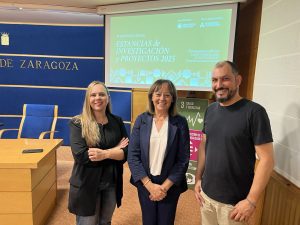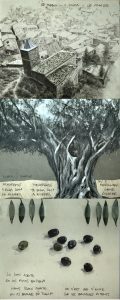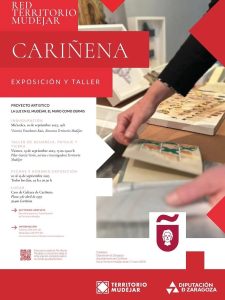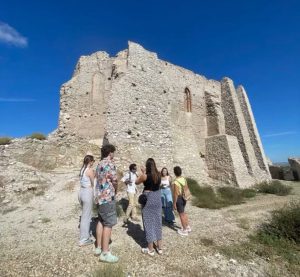
Territorio Mudéjar has added four municipalities to its network, bringing the total number of associated towns to 41. These towns will benefit from a program of activities to strengthen the management, research, and dissemination of Mudejar heritage, as well as the creation of a network of professionals and jobs linked to the management of these historical and artistic resources. The association of municipalities, promoted by the Zaragoza Provincial Council, recently held its annual meeting, during which it ratified the inclusion of the towns of Utebo—where the Mudejar tower of the Church of Nuestra Señora de la Asunción stands out—Alpartir—with a Mudejar legacy that survives in its urban planning, traditions, and landscape—Villarroya de la Sierra—where the influence can be seen in the water system, construction systems, and urban planning—and Acered—with the plasterwork of the Church of the Assumption of the Virgin as its representatives.
At the meeting, chaired by the mayor of Tobed, Juan Antonio Sánchez Quero, and attended by the mayors of the member municipalities, Victoria Trasobares, director of the organization, presented the plan of activities being developed for 2022.
This program maintains a commitment to research on Mudejar culture through the Gonzalo M. Borrás Gualis Research Internships and Projects (a new call will be announced soon), the search for best practices, curricular and extracurricular internships, and participation in programs such as Desafío (Challenge), internships for recent graduates, UNITA, and Circular por la Escuela Rural (Circular through Rural Schools), the latter of which aims to generate value for schools and encourage the selection of rural schools as permanent destinations for teachers. It also works to professionalize the profiles dedicated to heritage management and to provide a decidedly innovative approach to all its activities with the participation of local stakeholders.
Added to this is the research-based digitization strategy with the project “Study of Aragonese Mudejar Art, Legacy of Gonzalo M. Borrás Gualis.” This project, in collaboration with the Ministry of Education, aims to provide quality content for all projects launched and generate activity in the municipalities with the presence of highly qualified professionals.
As part of its commitment to disseminating the Mudejar heritage, this year the association will continue with thematic routes to promote both the historical and artistic heritage of each town and its other tourist attractions: hospitality, commerce, crafts, nature, and gastronomy. Likewise, the dissemination of heritage will be enhanced through media specials, podcast routes as audio guides, and through the information center to address and forward all tourist requests (24-hour telephone: 976 633 296). Territorio Mudéjar was founded in 2018, promoted by the Zaragoza Provincial Council as an association of municipalities whose objective is to strengthen a unified and collaborative management network for the use of historical and artistic resources linked to the important Mudejar heritage. These resources are understood as an engine of development for towns and as an element of identity for the maintenance of the communities that make up the territory.
Territorio Mudéjar has added four municipalities to its network, bringing the total number of associated towns to 41. These towns will benefit from a program of activities to strengthen the management, research, and dissemination of Mudejar heritage, as well as the creation of a network of professionals and jobs linked to the management of these historical and artistic resources. The association of municipalities, promoted by the Zaragoza Provincial Council, recently held its annual meeting, during which it ratified the inclusion of the towns of Utebo—where the Mudejar tower of the Church of Nuestra Señora de la Asunción stands out—Alpartir—with a Mudejar legacy that survives in its urban planning, traditions, and landscape—Villarroya de la Sierra—where the influence can be seen in the water system, construction systems, and urban planning—and Acered—with the plasterwork of the Church of the Assumption of the Virgin as its representatives.
At the meeting, chaired by the mayor of Tobed, Juan Antonio Sánchez Quero, and attended by the mayors of the member municipalities, Victoria Trasobares, director of the organization, presented the plan of activities being developed for 2022.
This program maintains a commitment to research on Mudejar culture through the Gonzalo M. Borrás Gualis Research Internships and Projects (a new call will be announced soon), the search for best practices, curricular and extracurricular internships, and participation in programs such as Desafío (Challenge), internships for recent graduates, UNITA, and Circular por la Escuela Rural (Circular through Rural Schools), the latter of which aims to generate value for schools and encourage the selection of rural schools as permanent destinations for teachers. It also works to professionalize the profiles dedicated to heritage management and to provide a decidedly innovative approach to all its activities with the participation of local stakeholders.
Added to this is the research-based digitization strategy with the project “Study of Aragonese Mudejar Art, Legacy of Gonzalo M. Borrás Gualis.” This project, in collaboration with the Ministry of Education, aims to provide quality content for all projects launched and generate activity in the municipalities with the presence of highly qualified professionals.
As part of its commitment to disseminating the Mudejar heritage, this year the association will continue with thematic routes to promote both the historical and artistic heritage of each town and its other tourist attractions: hospitality, commerce, crafts, nature, and gastronomy. Likewise, the dissemination of heritage will be enhanced through media specials, podcast routes as audio guides, and through the information center to address and forward all tourist requests (24-hour telephone: 976 633 296). Territorio Mudéjar was founded in 2018, promoted by the Zaragoza Provincial Council as an association of municipalities whose objective is to strengthen a unified and collaborative management network for the use of historical and artistic resources linked to the important Mudejar heritage. These resources are understood as an engine of development for towns and as an element of identity for the maintenance of the communities that make up the territory.
Territorio Mudéjar has added four municipalities to its network, bringing the total number of associated towns to 41. These towns will benefit from a program of activities to strengthen the management, research, and dissemination of Mudejar heritage, as well as the creation of a network of professionals and jobs linked to the management of these historical and artistic resources. The association of municipalities, promoted by the Zaragoza Provincial Council, recently held its annual meeting, during which it ratified the inclusion of the towns of Utebo—where the Mudejar tower of the Church of Nuestra Señora de la Asunción stands out—Alpartir—with a Mudejar legacy that survives in its urban planning, traditions, and landscape—Villarroya de la Sierra—where the influence can be seen in the water system, construction systems, and urban planning—and Acered—with the plasterwork of the Church of the Assumption of the Virgin as its representatives.
At the meeting, chaired by the mayor of Tobed, Juan Antonio Sánchez Quero, and attended by the mayors of the member municipalities, Victoria Trasobares, director of the organization, presented the plan of activities being developed for 2022.
This program maintains a commitment to research on Mudejar culture through the Gonzalo M. Borrás Gualis Research Internships and Projects (a new call will be announced soon), the search for best practices, curricular and extracurricular internships, and participation in programs such as Desafío (Challenge), internships for recent graduates, UNITA, and Circular por la Escuela Rural (Circular through Rural Schools), the latter of which aims to generate value for schools and encourage the selection of rural schools as permanent destinations for teachers. It also works to professionalize the profiles dedicated to heritage management and to provide a decidedly innovative approach to all its activities with the participation of local stakeholders.
Added to this is the research-based digitization strategy with the project “Study of Aragonese Mudejar Art, Legacy of Gonzalo M. Borrás Gualis.” This project, in collaboration with the Ministry of Education, aims to provide quality content for all projects launched and generate activity in the municipalities with the presence of highly qualified professionals.
As part of its commitment to disseminating the Mudejar heritage, this year the association will continue with thematic routes to promote both the historical and artistic heritage of each town and its other tourist attractions: hospitality, commerce, crafts, nature, and gastronomy. Likewise, the dissemination of heritage will be enhanced through media specials, podcast routes as audio guides, and through the information center to address and forward all tourist requests (24-hour telephone: 976 633 296). Territorio Mudéjar was founded in 2018, promoted by the Zaragoza Provincial Council as an association of municipalities whose objective is to strengthen a unified and collaborative management network for the use of historical and artistic resources linked to the important Mudejar heritage. These resources are understood as an engine of development for towns and as an element of identity for the maintenance of the communities that make up the territory.



